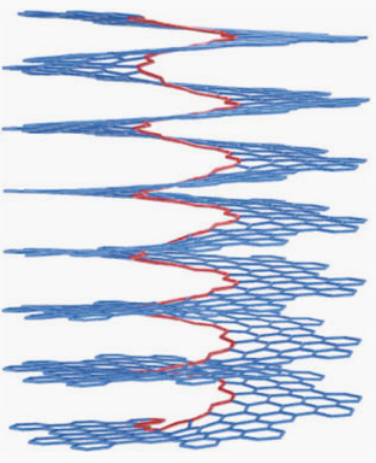Albert Einstein is credited with developing general relativity equations using Riemann geometry. Riemann geometry has offered predictions for the properties of curved carbon materials, in addition to its important role in mathematics and physics. The synthesis of such complex carbon materials with Riemann surfaces, on the other hand, has remained a significant challenge.
 Illustration of CNS with Riemann surface. Image Credit: Jinyi Wang, et al.
Illustration of CNS with Riemann surface. Image Credit: Jinyi Wang, et al.
A research team led by Prof. Pingwu Du from the Chinese Academy of Sciences and the University of Science and Technology of China (USTC) reported a simple synthesis of a π-extended nanographene carbon nanosolenoid (CNS) material.
As is typical of Riemann surfaces, the material was made up of continuous spiral graphene planes. Photoluminescence and magnetic properties were unique to the CNS. The study was published in the Nature Communications journal.
To create the material, researchers used a Pd-mediated Suzuki coupling to make polyphenylene precursor (P1). They then performed a Scholl reaction as the cyclodehydrogenation process. The researchers found differences in the solid-state nuclear magnetic resonance (NMR) and Fourier transform infrared (FT-IR) spectrum between P1 and CNS, confirming its existence.
In comparison to P1, CNS had a red-shifted emission band due to its extended π-conjugation. P1 and CNS have different lifetimes as evaluated by the time-resolved photoluminescence (TRPL) method, implying that large π-conjugation has an impact on CNS.
Due to its high energy output, traditional TEM would cause structural damage to the CNS. Scientists used a low-dose integrated differential phase contrast scanning transmission electron microscopy (iDPC-STEM) technique to examine single-stranded CNS helix. The examined helical pitch and width were very close to the calculation.
The magnetic and electronic properties of CNS were then investigated. At room temperature, a large number of radicaloids existed in CNS, as shown by electron paramagnetic resonance (EPR) spectroscopy. Magnetometry using a superconducting quantum interference device (SQUID) revealed a magnetization memory effect below 150 K. Furthermore, below 10 K, a large thermal hysteresis was observed as a result of the helix structure breaking π-electrons.
The current study established a simple synthetic method of CNS with Riemann surfaces, allowing researchers to investigate novel physical properties of such materials.
Journal Reference:
Wang, J., et al. (2022) Synthesis of a magnetic π-extended carbon nanosolenoid with Riemann surfaces. Nature Communications. doi.org/10.1038/s41467-022-28870-z.